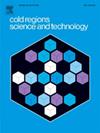冻融循环过程中土壤中未冻水的实验表征及滞回模型
IF 3.8
2区 工程技术
Q1 ENGINEERING, CIVIL
引用次数: 0
摘要
冻融循环过程中未冻水的滞回效应对土壤的水热特性影响很大。为了更好地了解土壤中未冻水的滞回特性,本研究利用频域反射法测量了粉质粘土中未冻水含量在温度逐步变化和快速变化两种模式下的变化。分析了土壤中未冻水的滞回效应,揭示了其背后的机理。结果表明,在两种温度变化模式下,未冻水含量的变化是一致的,在两种情况下都存在滞后现象。这种效应在温度快速变化模式下更为明显,初始含水率较高的土样在此模式下冻结时间较早,解冻速度较慢。迟滞现象主要受冰晶亚稳成核、孔隙冰结晶的阻塞效应以及相变过程中孔隙水压力的变化等因素影响。土壤冻结初期未冻水滞回的主要原因是亚稳成核过程。在冻结后期,滞后效应主要由孔隙冰结晶的阻塞效应引起的毛细水曲率的变化和冰-水相变过程中孔隙水压力的变化驱动。提出了一种迟滞模型,并根据实验数据和现有模型进行了验证,该模型具有良好的性能,能够准确预测不同温度条件下的未冻水含量。本研究增强了对冻土中未冻水含量迟滞效应机理的认识。本文章由计算机程序翻译,如有差异,请以英文原文为准。
Experimental characterization and hysteresis modeling of unfrozen water in soil during freezing-thawing cycle
The hysteresis effect of unfrozen water during freeze-thaw cycles greatly influences the hydrothermal properties of soil. To better understand the hysteresis behavior of unfrozen water in the soil, this study utilized frequency domain reflectometry to measure the unfrozen water content variations in silty clay under both stepwise and rapid temperature change modes. The hysteresis effect of unfrozen water in soil was analyzed, also the underlying mechanism was revealed. The results indicate that unfrozen water content variations are consistent across the two temperature change modes, with hysteresis observed in both scenarios. This effect was more noticeable during the rapid temperature change mode, and soil samples with higher initial moisture content froze earlier and thawed more slowly in this mode. The hysteresis phenomena are mainly influenced by the ice crystal metastable nucleation, the blockage effect of pore ice crystallization, and the pore water pressure changes during phase transition. The main cause of unfrozen water hysteresis in soil during the initial freezing phase is the metastable nucleation process. In the later stages of freezing, the hysteresis effect is primarily driven by changes in capillary water curvature, induced by the blockage effect of pore ice crystallization, and shifts in pore water pressure during the ice-water phase transition. Also, a hysteresis model was proposed and validated against experimental data and existing models, demonstrating good performance and accurately predicting unfrozen water content under varying temperature conditions. This research enhances the understanding of the mechanism responsible for the hysteresis effect of unfrozen water content in frozen soil.
求助全文
通过发布文献求助,成功后即可免费获取论文全文。
去求助
来源期刊

Cold Regions Science and Technology
工程技术-地球科学综合
CiteScore
7.40
自引率
12.20%
发文量
209
审稿时长
4.9 months
期刊介绍:
Cold Regions Science and Technology is an international journal dealing with the science and technical problems of cold environments in both the polar regions and more temperate locations. It includes fundamental aspects of cryospheric sciences which have applications for cold regions problems as well as engineering topics which relate to the cryosphere.
Emphasis is given to applied science with broad coverage of the physical and mechanical aspects of ice (including glaciers and sea ice), snow and snow avalanches, ice-water systems, ice-bonded soils and permafrost.
Relevant aspects of Earth science, materials science, offshore and river ice engineering are also of primary interest. These include icing of ships and structures as well as trafficability in cold environments. Technological advances for cold regions in research, development, and engineering practice are relevant to the journal. Theoretical papers must include a detailed discussion of the potential application of the theory to address cold regions problems. The journal serves a wide range of specialists, providing a medium for interdisciplinary communication and a convenient source of reference.
 求助内容:
求助内容: 应助结果提醒方式:
应助结果提醒方式:


